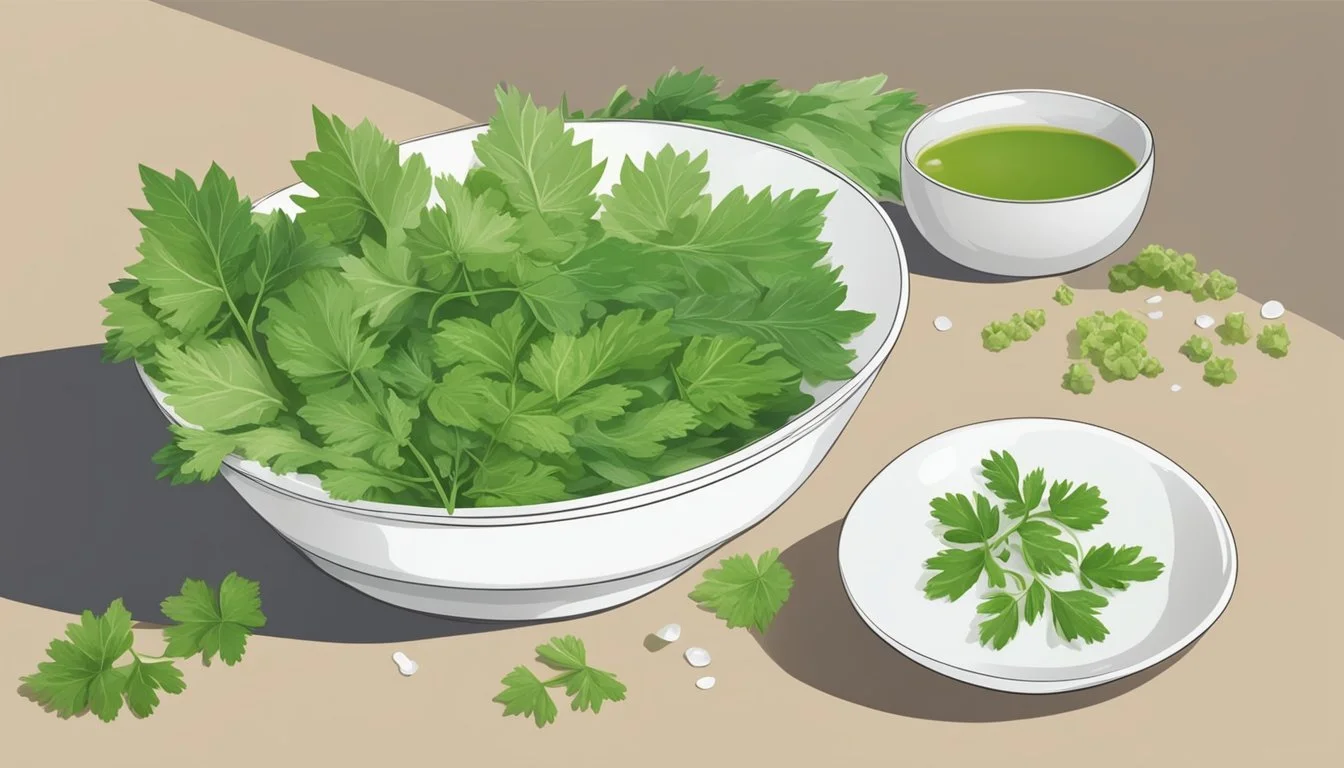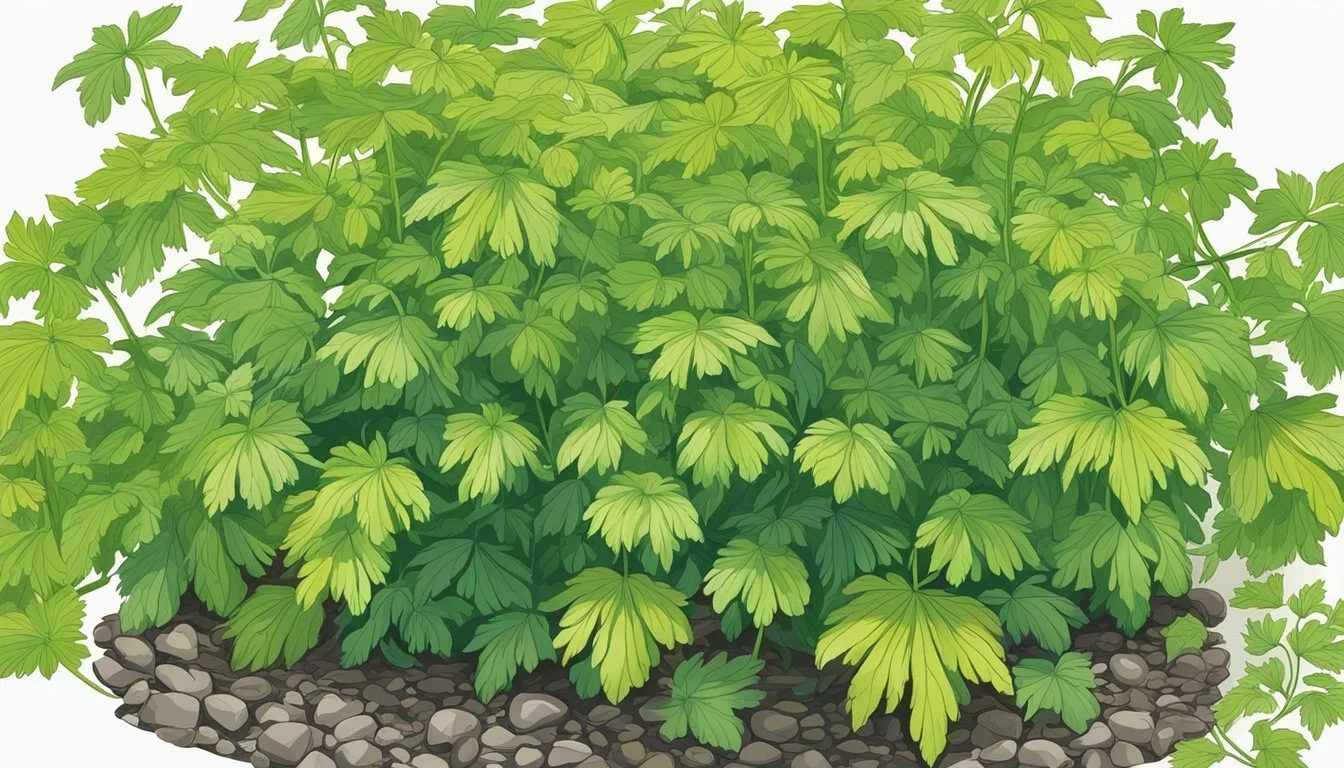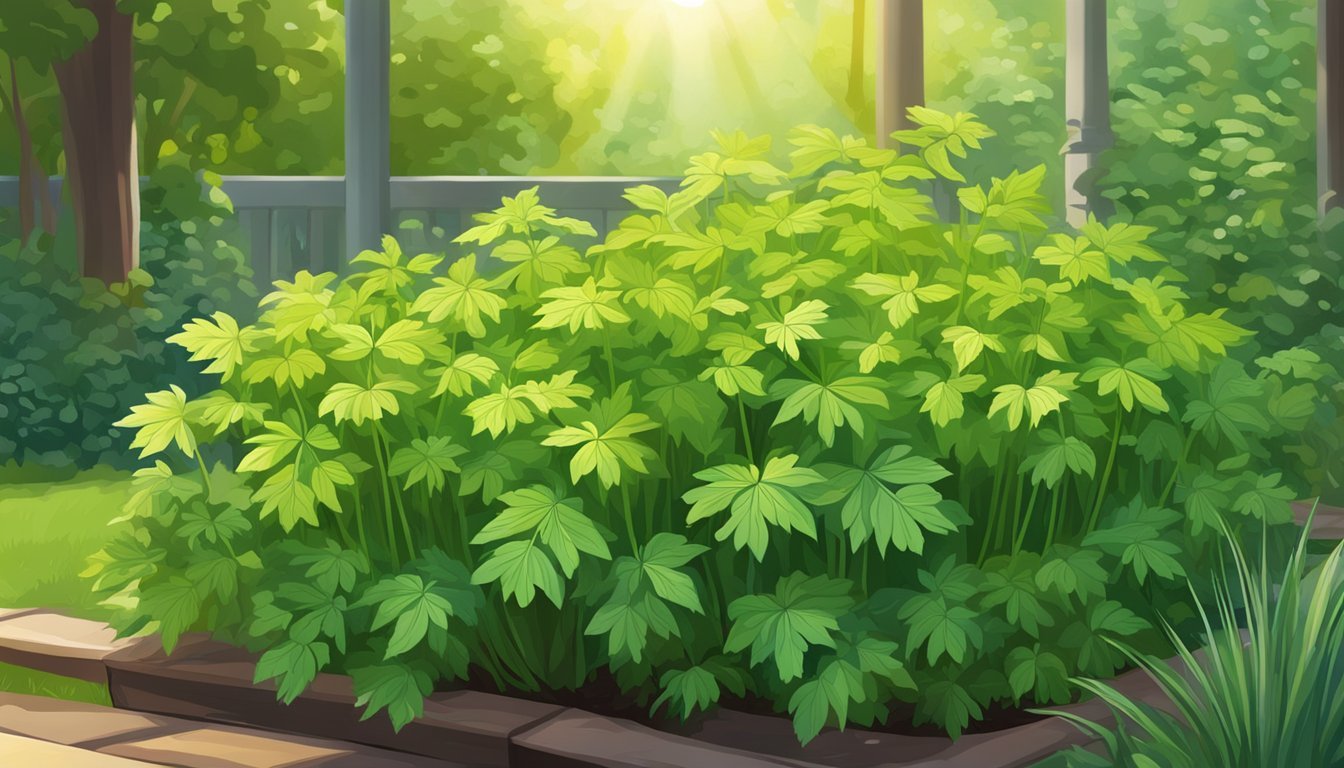Reviving Limp Lovage
Tips for Refreshing Your Culinary Herbs
Lovage is a perennial herb that is treasured in gardens and kitchens for its celery-like flavor and versatility. Recognizable by its large, dark green leaves, the plant imparts a robust taste that is stronger than celery, making it a flavorful addition to soups and salads. Despite its strength, it can become limp or wilted if not stored correctly, diminishing its appeal and culinary uses. Reviving limp lovage requires specific techniques to restore its crispness and ensure that its unique flavor continues to enhance a wide array of dishes.
As an herb with a rich history, lovage stands out for its multifunctional parts, including leaves, stems, and seeds, all of which are edible. The leaves can be chopped finely and added fresh to salads or as a garnish to soups, offering a refreshing and aromatic touch. When used in cooking, it's advisable to incorporate lovage in smaller quantities than celery to prevent overpowering the dish, considering its concentrated flavor profile. The hollow stems can serve as a flavorful substitute for celery in cooked recipes, bringing a depth of flavor to broths and stews. In the culinary realm, the ability to rescue and rejuvenate wilted lovage is an invaluable skill, ensuring that not a single leaf goes to waste.
Maintaining the quality of lovage from garden to table is crucial. When initially harvested or purchased, immediate proper storage is key, but if the herb does show signs of wilting, there are reliable methods to revive it. Allowing the herb to rehydrate through immersion in cold water can often bring back its desirable crispness, making it ready for use once more. This resilience, alongside its potent flavor, secures lovage's position as a beloved herb in the cooking world, continuing a legacy that extends back to traditional European cuisines.
Understanding Lovage
Lovage, scientifically known as Levisticum officinale, is a versatile perennial herb that brings a wealth of flavor and aromatic benefits to gardens and kitchens. This section will outline the botanical profile of lovage, discuss its cultivation and growth, and review the optimal growing conditions for this herb.
Botanical Profile
Lovage is a member of the Apiaceae family, which it shares with vegetables and herbs like celery and parsley. It is native to the Mediterranean region of Europe and Western Asia. Levisticum officinale is characterized by its tall stature, often reaching heights of up to 2 meters, and features deep green, shiny leaves that are similar in taste to celery. The plant produces small, yellow flowers followed by seeds that also possess culinary value.
Cultivation and Growth
As a hardy perennial, lovage emerges each spring and can be grown successfully in a garden setting. It is generally propagated from seed or root division. When growing lovage from seed, gardeners should sow directly in well-drained soil during spring. Once established, the plant is relatively low maintenance.
Lifecycle Planting Season Harvest Time Hardy Perennial Spring Leaves: Spring-Summer, Roots: Autumn
Optimal Growing Conditions
For optimal growth, lovage requires full sun to partial shade, which supports vigorous leaf production. While lovage does thrive in full sunlight, light afternoon shade in warmer regions can prevent the leaves from becoming too harsh due to intense heat. The plant prefers a cool to warm climate, being able to withstand European temperatures and even light frosts.
Soil: Must be well-drained, rich in organic matter, and moist.
Watering: Regular, to keep the soil consistently moist without waterlogging.
Temperature: Cool to warm, frost-tolerant.
By understanding and providing the proper light, temperature, and soil conditions, gardeners can enjoy the crisp and aromatic leaves of lovage in their culinary creations for years to come.
Growing Lovage at Home
Growing lovage at home provides a bountiful supply of this celery-like herb, ensuring fresh leaves, stems, and seeds for culinary use all season long. Proper propagation, regular maintenance, and effective harvesting techniques are key to a successful lovage garden.
Propagation Methods
Lovage can be propagated from seeds or by division.
Seeds: Sow indoors using well-draining soil, approximately 6-8 weeks before the last frost. It's important to maintain a germination temperature around 18-22°C (65-72°F) for successful seedling growth.
Division: Divide mature plants in early spring or autumn by carefully splitting the root ball, ensuring each section has ample roots.
Planting and Maintenance
Once seedlings are strong, transplant outdoors in a location with full sun to partial shade. Lovage flourishes in rich soil high in organic matter.
Soil: Enhance garden soil with compost or a soil-based mix, like John Innes No. 3, which supports healthy growth.
Containers: For indoor planting, select deep containers to accommodate the long taproot, and use the same soil-based mix.
Water and Mulch: Maintain even moisture without waterlogging. Applying mulch conserves moisture and suppresses weeds.
Harvesting Techniques
Lovage leaves can be harvested fresh, while stems and seeds can be collected for immediate use or preservation.
Leaves: Pick young leaves for the best flavor, washing and using them immediately in dishes or drying them for later use.
Stems: Cut stems as needed, ensuring you do not remove more than one-third of the plant at a time.
Seeds: When flowers dry and develop into seed heads, hang them upside down in a paper bag to catch seeds as they fall out. Store dried seeds in a cool, dark place.
Preservation: To preserve, lovage can be dried, frozen, or stored in a cool, dry area.
Following these guidelines allows gardeners to cultivate and enjoy their own lovage, adding a unique and aromatic flavor to their kitchen repertoire.
Culinary Uses of Lovage
Lovage, with its robust celery-like flavor, is a versatile herb that can elevate a variety of dishes. Its use in the culinary world ranges from subtle flavor enhancement to being the star of the dish across multiple preparations.
Enhancing Flavors
Lovage leaves impart a rich, slightly anise-like flavor reminiscent of celery seed. When used fresh, they can add a bright note to Mediterranean-inspired salads and sauces. The stems and roots, with their concentrated taste, are excellent for deepening the flavors in stews and soups.
Fresh lovage leaves: Aromatic, akin to celery with a hint of anise
Stems and roots: Ideal for robust dishes, good substitute for celery in cooking
Seeds: They give a concentrated earthy, celery-like taste suitable for pickles, dressings and as a spice in breads
Ingredient Preparation
To best utilize lovage in cooking, begin by thoroughly washing the leaves, stems, or roots. For leaves, a rough chop will suffice, whereas stems and roots should be finely diced to more evenly distribute the flavor.
Washing: Gently rinse under cold water.
Chopping:
Leaves: Rough chop and add to dishes for a fresh taste.
Stems/Roots: Finely dice before cooking.
Lovage-Inspired Dishes
Lovage shines in an array of recipes, enhancing the taste of fish, complementing the earthiness of potatoes, or creating a unique twist in soups and salads. It serves well in both fresh applications and cooked forms.
Soups: Adds depth with a few sprigs or leaves.
Salads: Chopped leaves can offer a refreshing twist.
Fish: Season with chopped leaves to emphasize natural flavors.
Tea: Fresh or dried leaves can be infused for a soothing herbal tea.
Incorporating lovage into one's culinary routine not only diversifies the palate but adds an element of sophistication to everyday cooking.
Health Benefits and Uses
Lovage is a robust herb known for its celery-like flavor and is revered for both its nutritional contributions to diets and its various medicinal properties. This herb's utilization spans from kitchen applications in enhancing dishes to traditional remedies supporting bodily functions.
Nutritional Value
Lovage is a nutrient-dense herb, providing a substantial amount of essential vitamins and minerals. Vitamin C, an antioxidant, is prevalent in the leaves, along with vitamin A and vitamin K which are important for immune function and blood coagulation, respectively. Minerals in lovage include calcium, iron, and potassium, each contributing to bone health, oxygen transport, and heart function.
Nutrient Profile:
Vitamins: A, C, K
Minerals: Calcium, Iron, Potassium
Medicinal Applications
Historically, lovage has been valued as a medicinal herb with a range of applications. It is credited with aiding digestion, potential aphrodisiac effects, and supporting respiratory health. The herb contains coumarins, limonene, camphor, and eugenols, compounds that have been associated with various health benefits, from stimulating appetite to providing relief from stomach disorders.
Medicinal Uses:
Digestion: May help in alleviating symptoms of indigestion and maintaining healthy digestion.
Respiratory Support: Used in treating conditions such as bronchitis.
Aphrodisiac: Sometimes used traditionally to stimulate libido.
It's important to consult with a healthcare professional before using lovage for medicinal purposes, as it can interact with certain medications and conditions.
Gardening Tips for Lovage
Lovage thrives in conditions similar to its relatives: fennel, carrot, and parsley, requiring particular attention to pest and disease management as well as seasonal care for replanting.
Pest and Disease Management
Pest Control: Lovage can be susceptible to the same pests that target related plants like fennel and parsley, such as leaf miners. These pests can be identified by the trails they leave on the leaves. Introducing beneficial insects, such as ladybugs, can help manage these pests. It's crucial to inspect the plants regularly and remove pests by hand if necessary.
Common Pests:
Aphids
Leaf miners
Disease Prevention: Lovage is relatively robust but still vulnerable to some diseases, particularly in damp conditions. Frequent inspection for the first signs of rot or mildew is important. Ensuring proper air circulation around the plants and soil drainage can help prevent disease.
Preventative Measures:
Avoid over-watering
Maintain proper spacing
Seasonal Care and Replanting
Sunlight and Hardiness: Lovage is hardy and can survive in cold conditions; however, it performs best in full sunlight. It thrives in a Mediterranean climate and should ideally receive at least six hours of sun daily.
Sunlight Needs:
Minimum of 6 hours of full sun
Watering and Feeding: Lovage prefers consistent moisture, especially when it is actively growing in spring and summer. However, it does not tolerate waterlogged soil, so it is vital to ensure good drainage.
Water Requirements:
Regular watering that maintains moist soil without being waterlogged
Replanting: While lovage is a perennial, it may benefit from division and replanting every few years to rejuvenate older plants and prevent overcrowding.
Replanting Tips:
Divide plants in early spring or fall
Space new plants adequately to ensure air flow
Lovage Preservation and Storage
To maintain the flavor and quality of lovage, proper preservation and storage methods are crucial. The leaves and seeds of lovage can be preserved through drying, providing a supply of this celery-like herb for culinary uses throughout the year.
Drying and Storing Leaves
When harvesting lovage for drying, it's best to do so before the plant flowers. This ensures the leaves retain their robust flavor. The drying process is straightforward:
Collect fresh lovage leaves.
Rinse them gently and pat dry.
Lay the leaves out on a drying rack in a well-ventilated area, away from direct sunlight.
Allow the leaves to become completely dry, which may take several days.
Once dried, store the leaves in airtight containers away from light and moisture to preserve their flavor.
It's important to check the leaves periodically during the drying process to ensure they do not mold. If the drying area is not sufficiently ventilated, a fan can help circulate air and reduce drying time.
Seed Harvest and Use
Lovage seeds are edible and can be used as a spice similar to celery seeds. To harvest seeds:
Wait until the seeds turn tan or brown, indicating they are ripe.
Cut the seed heads and place them in a paper bag.
Shake or rub the seed heads between fingers to release the seeds.
For storage:
Make sure the seeds are fully dry before storing to prevent mold.
Once dry, store them in a cool, dry place, ideally in a container that blocks light.
Dried lovage seeds can add a unique flavor to soups, stews, and salads.
Both the dried leaves and seeds should be checked occasionally for signs of moisture to prevent spoilage.
Conclusion
Lovage is a robust perennial herb that adds a dynamic celery-like flavor to various culinary preparations. Gardeners appreciate it for its resilience and versatility in the garden. If one's lovage appears limp, they can refresh it by trimming the ends and placing the stems in ice water. This trick crisps up the herb, restoring its vibrancy for salads and soups.
In the kitchen, lovage's distinctive taste enhances dishes with mere sprinkles of its leaves. This herb's leaves, seeds, and roots are all utilized, offering a range of flavors and uses. As with all herbs, moderation is key; too much can overpower a dish. Its assertive flavor means that a small amount can go a long way.
Advantages of cultivating lovage include:
Perennial Growth: Once established, it regrows every spring.
Diverse Culinary Uses: Provides flavor for soups, stews, and salads.
Aromatic Properties: Adds a fresh scent to the garden and kitchen.
A garden that includes lovage benefits from its height and lush foliage, making it not only a practical culinary herb but also an aesthetically pleasing addition. With proper care and periodic rejuvenation, lovage remains a staple in herb gardens and kitchens alike.






